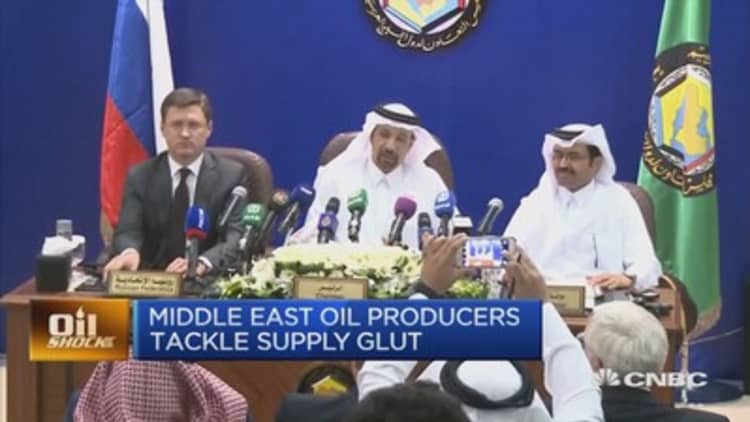
U.S. oil futures reversed course Thursday after threatening to crack $50 per barrel Wednesday, with just weeks to go before OPEC and other producers have to sign off on a new deal to hold down production.
The rapid decline in prices Wednesday was partly a technical response to the May futures contract's expiration, as well as a negative response to an unexpected increase in U.S. gasoline supplies. That futures contract expires at the close Thursday, and it lost 3.8 percent to $50.44 per barrel Wednesday. The June contract fell to about the same level.
But on Thursday Saudi Arabia's oil minister helped calm crude, which was higher in early U.S. trading.
Saudi Arabia's energy minister Khalid al-Falih, speaking at a conference in Abu Dhabi, suggested there are behind the scenes negotiations among oil producers ahead of OPEC's May meeting, according to the Wall Street Journal. He said there was a preliminary agreement to extend production cuts, but some OPEC members have yet to approve it.
OPEC, Russia and other producers agreed in December to a six-month deal to cut 1.8 million barrels from the world market, helping boost oil prices to the mid-$50s. But oil prices have waned whenever supply worries re-emerge. OPEC technical staff this month is expected to make a recommendation on whether to extend the cuts, and OPEC's monitoring committee meets the day before OPEC's May 25 meeting.
"That tug of war in the mind of the market is bullish OPEC cuts, bearish U.S. recovery. That's still the market driver," said Michael Wittner, global head of oil research at Societe Generale. He noted U.S. production keeps increasing. "Do the production forces oppose? Yes. But do the numbers offset? No. The OPEC numbers are bigger, and it's much sooner. The size of the price drop today, it goes beyond the U.S. report or anything else fundamental. I think there's just some market positioning going on."
If West Texas Intermediate futures continued to drop, the decline could threaten equity prices, with the Dow already down more than 225 points in the past two days. WTI Thursday was trading just above $51.25, up nearly 1 percent.
If oil breaks $50 here, I think it's going to be going to center stage," said Art Cashin, director of floor operations at UBS. The $50 has been a key psychological level for the market, and it's seen as a level where some shale producers can ramp up production.
U.S. weekly inventory data Wednesday was slightly bearish with an unexpected 1.5 million barrel jump in gasoline supplies and another increase in U.S. oil production to near 9.3 million barrels a day, the highest level since August 2015. But U.S. crude supply fell by a million barrels.
"There was a big jump in refinery utilization. We went from 91 percent to 92.9 percent. We're approaching full capacity when you start getting up around these numbers," said John Kilduff of Again Capital. "It's bearish for gasoline in particular, to the extent the end product value comes down and pulls down the price of oil with it. The fact we're only down a million barrels on crude in the face of the refinery run rate speaks to how well supplied we continue to be. There was a misperception out there that when the refinery runs are finally cranked back up that you'd see these crude oil inventories plummet, and that's not the case."

"There's a lot of talk the [OPEC] agreement is going to be extended, but we have a full month to go before the [OPEC] talks are held," said Gene McGillian, manager of market research at Tradition Energy. "I think the real thing is without signs the production cuts are really impacting global inventories the market has trouble holding up near the upper end of the trading range."
As for the May contract, "some of the people who picked up contracts below $50 decided to run out ahead of expiration," he said.
Wittner said he expects OPEC to move toward an agreement, and none of the major players have been talking down a deal lately.
Helima Croft, head of global commodities research at RBC, said Russia may be particularly interested in re-signing since it needs a higher oil price to help its economy.
"The market has a hard time sustaining itself within striking distance of the year's highs," McGillian said.
Kilduff said there could be some short-covering Thursday that could boost prices. But if WTI heads lower and breaks down, he said, it could go into the upper $40s. "We've gotten down pretty quickly to test $50 support. It's been sticky … the big number to watch is $47. If we break that we're going to go to $42 and touch the November lows," he said.
McGillian said some of the geopolitical risk is also coming out of the oil price, as days go by with no further action by the U.S. against Syria. Also, the fact the U.S. ships were heading to the Indian Ocean and not North Korea, as originally reported, has brought down some of the concern about the heightened tensions between the U.S. and North Korea.
Markets on Thursday will also be watching earnings and a few economic reports, such as initial claims at 8:30 a.m. ET and the Philadelphia Fed survey, also at 8:30 a.m. ET. The leading index for March is reported at 10 a.m.
Earnings are expected from Verizon, Travelers, Blackstone, Bank of NY Mellon, Imax, MGIC Investment, KeyCorp and Danaher before the bell. After the bell, Visa and Mattel report.
Watch: Arab oil ministers discuss oil glut



